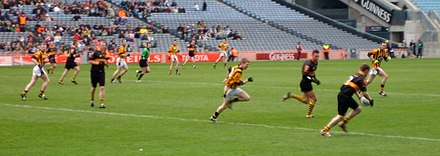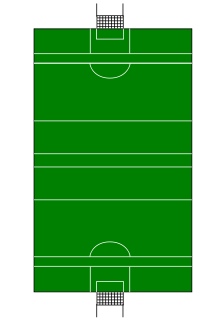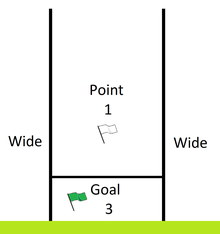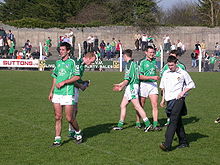Gaelic football
Gaelic Football ( Irish : peil Ghaelach , peil or caid for short ) is a team sport that has elements of rugby and football .

The sport is similar to other Celtic games and Australian football . It is mainly practiced in Ireland where, along with hurling, it is one of the most popular local sports. The organization of the sport is the responsibility of the Gaelic Athletic Association (GAA).
As a compromise between Irish and Australian rules, the form of International Rules Football was introduced to allow for international matches.
regulate
Cue ball
The ball has a circumference of 58 to 71 cm or a diameter of approx. 22 cm, weighs between 450 and 485 grams and is made of leather.
matchfield
It is usually played on grass. The playing field is 130 to 145 meters long and 80-90 meters wide. In the middle of the two basic lines of the playing field are the so-called scoring spaces . They are bounded by 2 goal posts each. The distance between the goal posts is 6.50 meters. The goalposts are at least 7 meters high. A crossbar runs between the goal posts at a height of 2.50 meters. The part below is called the gate. The goal nets are attached to the crossbar and the goal post. There are 2 rectangles in front of the scoring spaces . The smaller one is 14 meters wide and 4.50 meters long (goal area). The larger one is 19 meters wide and 13 meters long (penalty area). There is also a 20-meter line and a 45-meter line.
Teams and playing time
Each team consists of 15 players: a goalkeeper, three full-backs, three half-backs, two midfielders, three half-forwards and three full-forwards. A maximum of 6 substitutions are allowed during the game. In the event of extra time, 3 additional substitutions are allowed. In games of the National League or other so-called inter-county championship games, the playing time is 2 × 35 minutes. Otherwise the game is usually played twice for 30 minutes. The break is 5 or 10 minutes. If extra time is played, the additional playing time is 2 × 10 minutes.
game
The game is started by a throw-in by the referee at the center line. With the exception of 2 players on each team, all players must be behind the 45-meter lines.
Even if the game is called football, the ball can be played with any part of the body. However, with the exception of the goalkeeper, it is not allowed in his own goal area to pick up the ball with his hand. A player may take a maximum of four steps with the ball in hand. Holding the ball is only allowed for four seconds (usually wording: the time it takes to take four steps).
A popular way of guiding the ball is toe tapping . The ball is played from foot to hand again after a maximum of four steps. In addition, the ball can also be bounced on the floor, as in handball or basketball . A player in possession of the ball may switch the ball between hands once. When changing, both hands must touch the ball at the same time, ie it must not be thrown into the other hand. After every bounce or toe-tapping , another change of hands is permitted.
The ball may be passed on with all parts of the body. In the so-called hand pass , the ball has to be hit with the fist or the open hand. A striking movement must be clearly recognizable. Throwing the ball is not allowed under any circumstances.
Punish
After a foul, play continues with a free kick called a free kick. The free kick is taken at the location of the foul. If a foul is committed in the penalty area, there is a penalty kick from the midpoint of the 13-meter line. Only the goalkeeper of the other team is allowed to stand on the goal line. All other players stand behind the 20-meter line. With the exception of free kicks from the opponent's 13-meter line and the penalty kick, all free kicks may also be taken from the hand.
The game continues with a so-called kick-out when a team has scored a goal or a point (from the 20-meter line) or when the attacking team plays the ball out of the goal (from the respective goal area). The ball must be on the ground. If the ball is kicked out of the goal by the defending team, the attacking team receives a free kick (from the ground) from the 45-meter line. If one team plays the ball into touch, the other team receives a free kick from the hand from the touchline at the point where the ball left the field.
In Gaelic Football, a player can also be personally punished with cards. Here are Yellow , Red and Black card used.
The yellow card is a warning to the player concerned. It is used for minor offenses. A player will be given a yellow card if he:
- blocks the ball with his shoe or tries to do so after the opponent has released the ball from his hand,
- prevents an opponent from lifting or kicking the ball lying on the ground with his arm, hand, foot or leg,
- special hardness (rough style of play) or
- feigning an injury or foul play ( swallow ) to gain an advantage.
A player can only receive one yellow card. Another yellow or black card leads to the expulsion by means of a red card.
The black card has existed since 2014. This is a black card holder or notebook (known as a "tick" or "black book"), which the referee uses for notes and as a card. It is used for offenses for which a yellow card is no longer sufficient, but a direct red card is not yet justified. A player receives the black card if he:
- deliberately holding, pushing or pulling an opponent to the ground,
- deliberately tripping an opponent with his hand, arm, knee or foot or trying to
- jumps on an opponent or intentionally causes a collision with an opponent by using his body after the offending player has played the ball or made a movement to play,
- insulted or even threatened a teammate or opponent through provocative choice of words or gestures or
- protests against a decision by the umpire, umpire or linesman.
Until 2020, the black card, like the red card, meant a dismissal for the player. In the case of a direct black card, however, he could be replaced if he received it directly. Since the rule change at the beginning of March 2020, the black card now means a time penalty of 10 minutes. The black card is called "Sin Bin" because the player (like rugby) has to go to the penalty box. If a field player has seen the black card, he may not be replaced during this time. So the team has to play with one man less. If the goalkeeper sees the black card directly, he must also go to the penalty box. With him, the team now has two options: Either a field player of the same color goes into the goal or the goalkeeper is replaced by a change. The swap counts towards the 5 (downgraded from 6) normal swaps that the team has available throughout the game. In the extension, another 3 changes are made available. If the team has exhausted its substitution quota (6th substitution), it cannot replace the goalkeeper who has been sent off. A field player must then definitely take on the role of the goalkeeper and play the team with one man less.
The time penalty begins with the continuation of the game. It will also be included in the extension. In the event of a penalty shootout, the player may participate again. After the end of the penalty time, the player may only return to the field of play when the game has been stopped again and the referee then gives his consent. If the player enters the field of play without permission, he receives a yellow card. If a player receives another yellow or black card after receiving the direct black card, he sees the red card. He is sent off for the rest of the season and is not allowed to be replaced, so his team will play with one man less for the rest of the season.
A serious foul results in a red card. For the player, just like the black card, it means the expulsion for the rest of the game. The player may not be replaced in this case. A player receives the red card and is sent off without a substitute if he:
- hits or tries to hit a teammate or opponent with his arm, elbow, hand, knee or head,
- kicks or tries to kick a team-mate or an opponent and does so with minimal effort or causes an injury by kicking,
- endangers an opponent through his behavior,
- spits at an opponent,
- takes part in a scuffle,
- kicks a player,
- through reckless play, injuring the player or
- offends or threatens a referee, umpire or linesman with provocative words or gestures.
A player also sees the red card if he receives the yellow card twice in the game (after the 2nd yellow card he is shown the red card, i.e. yellow-red card ) or receives the black card as the 2nd card after he has already been shown was punished with the yellow card. Since the red card is shown after the black card, the player cannot be replaced.
If a player is expelled from the field for a second yellow or yellow and black card with a red card, this means a ban of 2 weeks if the offense occurs again within 48 weeks. There are at least 2 games for a direct red card.
Goals and Points (Scores)
A goal is scored by playing the ball over the goal line under the crossbar and between the goal posts. A point is scored by playing the ball over the crossbar and between the goal posts. A goal is worth 3 points. Goals and points can also be scored by hand. To do this, however, the ball must be in the air during the stroke or fist. It is not allowed to carry or throw the ball over the goal line. The counting method takes some getting used to. Goals and points are given separately. If you read the following final result: Kerry 2-12 Dublin 0-15, this means that Kerry wins with 18 points (2 goals of 3 points + 12 points), Dublin only has 15 points.
referee
A referee (Irish: Réiteoir ) is responsible for directing a game . He is supported by 2 line judges and 4 so-called umpires . The umpires act as gate judges, ie there is an umpire on each side of the two gates. They are easy to recognize by their white coats. The final decision always rests with the referee. He makes all decisions about goals, points, penalties, etc. The decisions made are final (so-called factual decision). The task of the umpires is to indicate goals and points. A point is indicated by the raising of a white flag and a goal by the raising of a green flag. A 45 meter free kick is indicated by raising an arm. If the attempt fails (wide), the arms are crossed over the head. The main task of the linesman is to indicate with a flag when and where the ball has left the field of play and which team is allowed to bring the ball back into play.
history
The first mention of a game called football in Ireland is in the Galway Statutes of 1527. The strict Sunday Observance Act of 1695 banned Sunday play. The fine for not following the ban was 1 shilling, which was a considerable amount of money at the time. But it turned out to be difficult, if not impossible, to enforce this ban.
Notes on football games can be found for both the 17th and 18th centuries. Poems in particular give an idea of the rough nature of the game at that time. It was more like a scuffle than an organized game. The poet Séamas Dall Mac Cuarta describes a game in Fennor near Slane in his poem Iomáin na Bóinne in 1670 . The poet Matt Concannon the Elder describes a game between teams from Lusk and Swords in 1720 in great detail. Various aspects such as catching, kicking and passing the ball are described in detail.
In the first half of the 19th century, a variant of football called Caid was very popular in parts of Ireland, particularly Kerry . A distinction was made between two forms of play. The field caid was played on a demarcated field. The branches of trees served as gates. The cross-country caid was about carrying the ball across the border of the opposing community. The games were usually played on the Sunday after going to church and often lasted all day.
During the 1860s and 1870s, rugby and association football became increasingly popular in Ireland. At the time, these sports were already set out in fairly fixed rules. Meanwhile, Caid was superseded by a game that was generally just called rough-and-tumble-game . As the name suggests, this game was rather wild and unbridled. There were few rules and almost anything was allowed to bring the opponent down or take the ball away from him.
With the formation of the Gaelic Athletic Association (GAA) in 1884, the days of these wild football games came to an end. The founders of the GAA, Michael Cusack , and Maurice Davin formulated the first binding rules for Gaelic football and laid the basis for today's game. The first game under these rules took place on February 15, 1885 in Callan , County Kilkenny . The new rules and the governing body ensured that the game quickly spread across Ireland.
Competitions
Gaelic football is an amateur sport. There is a club in almost every place in Ireland where you can play the game. At the lower level, only county championships are usually played. The championships are organized according to skill level and age:
- Senior: the strongest adult teams
- Junior: the weaker adult teams, mostly from smaller towns and villages
- Under-21: Players under the age of 21
- Minor: players under 18 years of age
- Underage: players under 16 years of age
At the national level, the teams are organized according to the old Irish county system. Despite the division of the island into what is now the Republic of Ireland and Northern Ireland in 1921, all Gaelic football teams across the island are still represented in the GAA and also take part in the championships. The Irish diaspora is represented by teams from London and New York City . Each county puts together a selection team with the best players from the clubs.
The most important competition is the All-Ireland Senior Football Championship . It has been played in the knockout system since 1887 and played from May to September. First, the game is played on the level of the four historic provinces of Leinster , Munster , Ulster and Connacht . In the past, the champions of the four provinces played the semi-finals and the winners of the semi-finals played the All-Ireland Final . In 2001 this system was modified. Teams that have dropped out at the provincial level have the opportunity to return to the championship competition via a consolation round. If a game ends in a draw, there is a so-called replay. This replay is then played until the decision is made.
In addition to the All-Ireland Championship, there has been the National Football League since 1927 , which is always played in spring. However, it is clearly overshadowed by All-Ireland, although the interest of players and audiences has grown steadily in recent years. The league is divided into four divisions.
The All-Ireland Final
The championship final is called the All-Ireland Final. It always takes place on the third Sunday in September at Croke Park in Dublin. Until 1996 it took place on the fourth Sunday of the month, but this was changed to straighten out the calendar a bit. The final regularly attracts over 80,000 spectators to the stadium. It is not just a major sporting event. Often the President and the Taoiseach are also present.
There is an All-Ireland Championship for senior and minor teams, with the minor teams consisting of players under the age of 18. The senior master receives the Sam Maguire trophy. The namesake for the cup is a well-known Gaelic football player and GAA official. After his death in 1927, the winner's cup was named after him. The most successful counties are Kerry with 37 and Dublin with 24 titles ( complete list of winners ).
literature
- Jack Mahon: A History of Gaelic Football Gill & Macmillan, Dublin 2001, ISBN 0-7171-3279-X
- Marcus de Bùrca: The GAA - A History Gill & Macmillan, Dublin 2000, ISBN 0-7171-3109-2
Web links
Individual evidence
- ↑ Anthony Redmond: List of rule changes in GAA for 2020 - Gaelic Football League and All Ireland - SportsNewsIreland SportsNewsIreland Live Scores. In: SportsNewsIreland. January 27, 2020, accessed March 4, 2020 (American English).






